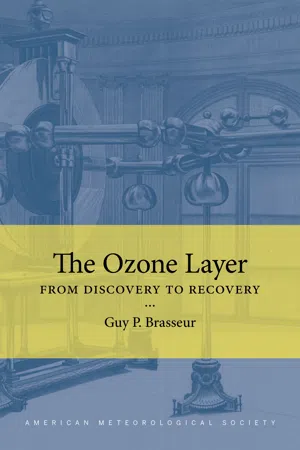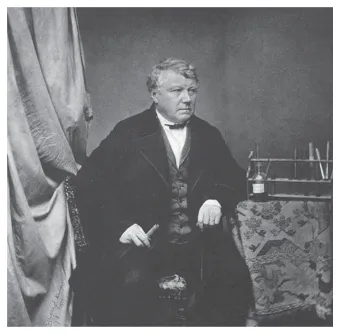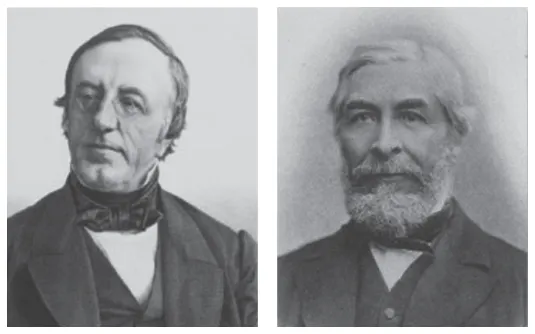
- English
- ePUB (mobile friendly)
- Available on iOS & Android
eBook - ePub
About this book
From the discovery of ozone in the eighteenth century, through the late twentieth-century international agreements to protect humanity from the destruction of ozone in the stratosphere, Guy P. Brasseur traces the evolution of our scientific knowledge on air quality issues and stratospheric chemistry and dynamics. The history of ozone research is marked by typical examples of the scientific method at work, perfectly illustrating how knowledge progresses. Hypotheses are contested and then eventually accepted or rejected; truths once believed to be universal and permanent can be called into question; and debates and disagreements between scientists are settled by information from laboratory and field experiments. Of course, the scientific method can also lead to new observations—in this case, the discovery of the ozone hole. This finding took researchers by surprise, leading to new investigations and research programs.
This first complete study of ozone research demonstrates the key role fundamental research plays in solving global environmental, climate, and human health problems. More importantly, it shows that the scientific method works. Convincing decision makers of research results that do not correspond to their values, or to the interests of certain business groups, stands to be the highest hurdle in using science to benefit humanity. Students, early-career scientists, and even specialists who do not know much about the history of their field will benefit from this big picture view, offered by a researcher who has played leadership roles in stewarding this science through decades of discovery.
This first complete study of ozone research demonstrates the key role fundamental research plays in solving global environmental, climate, and human health problems. More importantly, it shows that the scientific method works. Convincing decision makers of research results that do not correspond to their values, or to the interests of certain business groups, stands to be the highest hurdle in using science to benefit humanity. Students, early-career scientists, and even specialists who do not know much about the history of their field will benefit from this big picture view, offered by a researcher who has played leadership roles in stewarding this science through decades of discovery.
Frequently asked questions
Yes, you can cancel anytime from the Subscription tab in your account settings on the Perlego website. Your subscription will stay active until the end of your current billing period. Learn how to cancel your subscription.
No, books cannot be downloaded as external files, such as PDFs, for use outside of Perlego. However, you can download books within the Perlego app for offline reading on mobile or tablet. Learn more here.
Perlego offers two plans: Essential and Complete
- Essential is ideal for learners and professionals who enjoy exploring a wide range of subjects. Access the Essential Library with 800,000+ trusted titles and best-sellers across business, personal growth, and the humanities. Includes unlimited reading time and Standard Read Aloud voice.
- Complete: Perfect for advanced learners and researchers needing full, unrestricted access. Unlock 1.4M+ books across hundreds of subjects, including academic and specialized titles. The Complete Plan also includes advanced features like Premium Read Aloud and Research Assistant.
We are an online textbook subscription service, where you can get access to an entire online library for less than the price of a single book per month. With over 1 million books across 1000+ topics, we’ve got you covered! Learn more here.
Look out for the read-aloud symbol on your next book to see if you can listen to it. The read-aloud tool reads text aloud for you, highlighting the text as it is being read. You can pause it, speed it up and slow it down. Learn more here.
Yes! You can use the Perlego app on both iOS or Android devices to read anytime, anywhere — even offline. Perfect for commutes or when you’re on the go.
Please note we cannot support devices running on iOS 13 and Android 7 or earlier. Learn more about using the app.
Please note we cannot support devices running on iOS 13 and Android 7 or earlier. Learn more about using the app.
Yes, you can access The Ozone Layer by Guy P. Brasseur in PDF and/or ePUB format, as well as other popular books in Biological Sciences & Environmental Science. We have over one million books available in our catalogue for you to explore.
Information
CHAPTER ONE
The First Steps
The Discovery of Ozone
Christian Friedrich Schönbein (1799–1868), a prominent professor of chemistry at the University of Basel (Figure 1.1), was a specialist in electrolysis. He invented the fuel cell and discovered the explosive properties of nitrocellulose. Passionate about chemistry already at a young age, he started working as an apprentice at a pharmaceutical company in Böblingen, Germany, at the age of 13. In order to satisfy his ambition to explore the complex processes of chemistry, he passed several examinations organized by a professor of chemistry in Tübingen. In 1820, he did an apprenticeship training in a textile dyer company before enrolling as a student at the universities of Erlangen and Tübingen. In 1826, he moved to England to become a teacher in a reformatory house and later completed his studies in physics and chemistry at the Sorbonne in Paris. He joined the University of Basel in 1828, where he was promoted to “Ordinary Professor” in 1835. Schönbein became one of Europe’s most renowned chemists while being involved in the political affairs of the city of Basel. The famous chemist Justus von Liebig (1803–1873), professor at the University of Giessen and later of Munich, one of the founders of industrial agronomy, who met Schönbein for the first time in 1853, seemed to appreciate the company of his Basel colleague as in a letter to Friedrich Wöhler (1800–1882), professor at the University of Göttingen,1 he wrote:
Schönbein’s sense of humor is priceless; if only I had his stomach . . .2

Figure 1.1. Christian Friedrich Schönbein, professor at the University of Basel. Source: Photogravure after a painting by Beltz, c. 1860; original photo from the University of Basel Library.
During an experiment on the electrolysis of acidic water conducted in early 1839, Schönbein noticed a peculiar odor, similar to that produced by the oxidation of white phosphorus. It was very similar to the smell of “electric material” that Martin van Marum3 (1750–1837), a physician in the city of Harlem in the Netherlands, had reported 40 years earlier and that accompanied the production of electric arcs by a friction electrostatic generator that the Dutch scientist had built. In fact, as highlighted in the Odyssey and Iliad by Greek poet Homer (born sometimes between the twelfth and eighth century BC), the “divine odour of Zeus” had already been observed during Antiquity in relation to “Jupiter’s thunders” (lightning flashes).

Figure 1.2. (Left) Arthur de la Rive. Source: Wikipedia. (Right) Jean Charles Galissard de Marignac. Source: Orden pour le mérite für Wissenschaften und Künste. These two scientists showed that ozone is produced in an enclosure containing only oxygen.
On March 13, 1839, Schönbein went to a meeting of the Natural Sciences Society (Naturforschung Gesellschaft) in Basel and made his discovery public; the minutes of the meeting state, “Professor Schönbein told the Society of an odour that develops during the electrolysis of water.”4
It was only a few months later, however, in 1840, during a lecture he gave at the Academy of Sciences in Bavaria, that Schönbein suggested that the odor produced during the electrolysis of water should be attributed to a chemical substance, but he had not yet been able to identify this substance. Was it a particular molecule or a mixture of several chemical elements? Or simply, as suggested by the professor of Physics of Geneva, Arthur de la Rive (1801–1873; Figure 1.2), an odor produced by fine particulates released from the material constituting the electrode of the electrolysis cell? Schönbein refutes this last hypothesis by arguing that the same odor, detected in the vicinity of thunderstorms, was probably due to lightning strokes. He therefore argued that the odor recorded in his laboratory must be linked to the electrical arc produced during his experiment (see Box 1.1).
During a lunch at the university, Schönbein shared his discovery with his colleague Wilhelm Vischer-Bilfinger (1808–1874), a philologist and specialist in ancient Greek literature. Vischer suggested to name this odorous property “ozon” after the Greek word όζειν (ozein, to smell).5 Schönbein adopted this idea, which he communicated in 1840 to French academician François Arago6 (1786–1853) in a letter on the “nature of the odor that manifests itself in certain chemical actions.” This letter was read at the meeting of the Academy of Sciences in Paris on April 27, 1840. In an article published in German on April 8, 1840, and after having exposed the results of his work, Schönbein wrote,
After these remarks, I still make the proposal to name ozon the odorant principle if future research shows that it behaves as an elemental or composed halogen.7
A similar letter in which he mentioned the presence of the new odorous substance “accompanying electricity” was sent to his friend Michael Faraday (1791–1867) and read at a session of the Royal Society in London.
Identification of the Ozone Molecule
The nature of the “electric smell” was hotly debated because it was highly controversial. Schönbein was initially convinced that the electric discharge produced during the electrolysis of the water produces a gaseous substance that he first regarded as a halogen (chlorine or bromine). In his letter to Arago, he wrote,
Since I am pretty sure that the odorant principle must be classified according to the kind of body to which chlorine and bromine belong, i.e. elemental and halogenated substances, I propose to call it ozone. As I am convinced that this body is always released into the air in fairly noticeable quantities, when the weather is stormy, I propose to do a series of experiments this year to highlight the presence of ozone in our atmosphere.8
Yet seven years later, he revised himself and, in an article published in 1847, concluded that the substance emitted should contain oxygen and hydrogen atoms, and that it would probably be a high-order oxide HO3 rather than the hydrogen peroxide H2O2, a chemical substance discovered by Louis Jacques Thénard9 (1777–1857). Later, Schönbein suggested that ozone was actually the peroxy radical HO2. De la Rive was of a different opinion based on the experiments he had carried out in his laboratory and of which he reported in a letter to Arago in 1845:
We passed through a tube a stream of oxygen perfectly pure and perfectly dried up [. . .] Thus [. . .] ozone comes only from oxygen and, in order to have the manifestation of it, the simplest and most direct way is to produce a succession of electric sparks through a volume of pure oxygen.10
Encouraged by these experimental results, Jean Charles Galissard de Marignac (1817–1894; Figure 1.2), professor of chemistry at the Geneva Academy, who had also found that the characteristic smell of ozone appeared when an electric discharge was produced in a chamber containing pure oxygen, suggested that ozone is an allotropic form of oxygen. This conclusion was immediately rejected by Schönbein who considered that the enclosure used by de Marignac probably contained impurities and in particular traces of water vapor. In an article, “On the Nature and Production of the Ozone,” published in the Electricity Archives in 1845, de Marignac wrote,
The attention of chemists and physicists has been excited to a high degree by the remarkable phenomena which have been studied by Mr. Schönbein. The interest in the curious properties of ozone was further enhanced by the ingenious hypothesis through which the learned professor of Basel believed that he could explain these properties. However, chemists cannot easily adopt a theory that overturns all their doctrines on the simple nature of nitrogen, without collecting fully convincing evidence. [. . .] When the air is subject to a series of electric discharges [. . .], ozone develops, without the presence of water vapor being necessary. It seems to us from these facts that the oxygen is likely, in certain circumstances, to undergo a particular modification which enhances its chemical affinities, and makes it able to combine directly with bodies on which it is without action in its ordinary state. Ozone is nothing else than oxygen in this particular state of chemical activity, which results from the influence of an electric current.11
Until 1850, Schönbein remained convinced that ozone was indeed a compound of oxygen and hydrogen. But with the laboratory measurements made in Geneva, he finally had to realize that ozone contains only oxygen atoms. But in what form?
Two theories confronted each other immediately. The first theory expressed by Schönbein was based on the fact that the amount of ozone produced by an electric discharge in an oxygen-containing enclosure is unexpectedly low. It implies therefore that a chemical destruction process involving an unidentified substance reduces the net formation rate of ozone. In 1858, Schönbein imagined that ozone was a negatively electrified form of oxygen, and that its abundance was balanced by the presence of a similar quantity of positively electrified oxygen. In a letter to Michael Faraday, he used the name antozone to describe the positively charged oxygen substance, and considered that the “ordinary” oxygen molecule (O2) resulted from the combination of ozone and antozone. The contradictory hypotheses that Schönbein made over the years to characterize “the odor of electricity” puzzled Faraday who underlined his deep confusion in a letter sent to Schönbein in 1858 (see Box 1.2). At this point, it remained to characterize the chemical nature and the properties of antozone and to first isolate this compound in the laboratory.
Table of contents
- Cover Page
- Title Page
- Copyright Page
- Contents
- Preface
- Acknowledgments
- Introduction
- 1. The First Steps
- 2. The Presence of Ozone in the Atmosphere
- 3. Spectroscopic Determinations of Ozone
- 4. The First Theoretical Studies
- 5. Determination of the Vertical Distribution of Ozone
- 6. Advances in Theory
- 7. Ozone and Supersonic Aircraft
- 8. Ozone and Chlorofluorocarbons
- 9. The Antarctic Ozone Hole
- 10. Ozone in the Troposphere
- 11. A Success Story
- Selected Bibliography
- Index